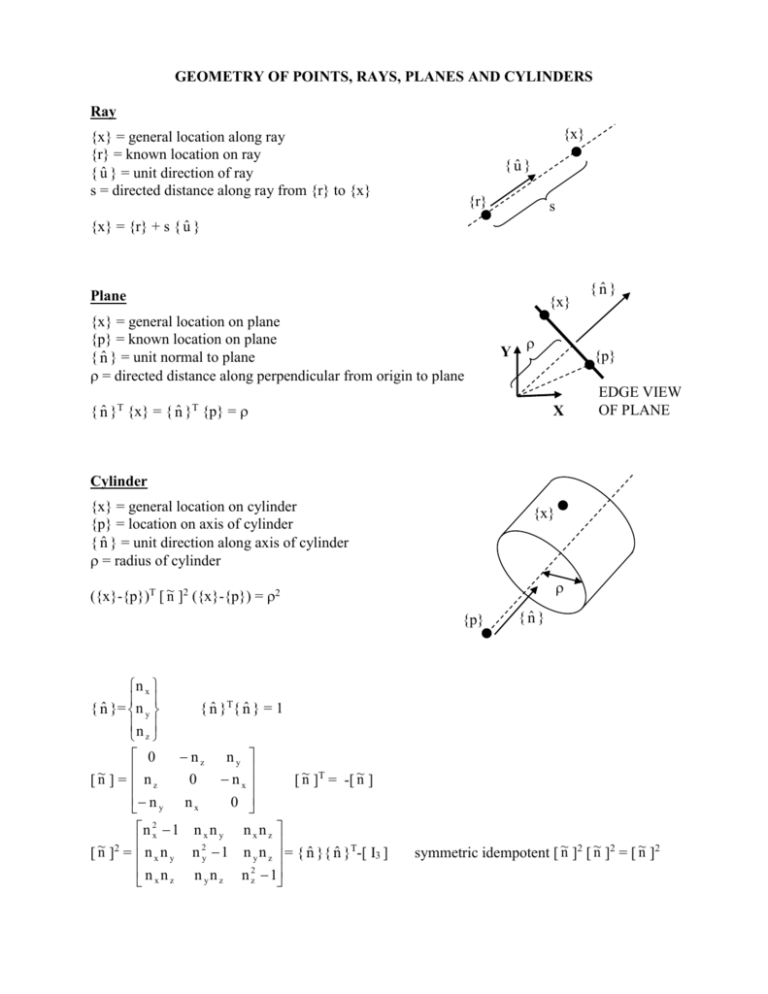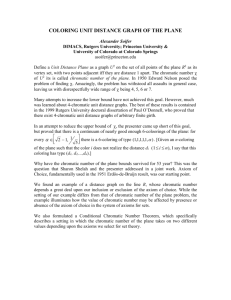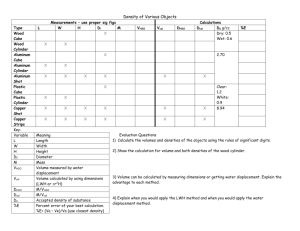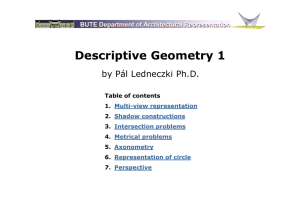GEOMETRY OF POINTS, RAYS, PLANES AND CYLINDERS
advertisement

GEOMETRY OF POINTS, RAYS, PLANES AND CYLINDERS
Ray
{x}
{x} = general location along ray
{r} = known location on ray
{ û } = unit direction of ray
s = directed distance along ray from {r} to {x}
{ û }
{r}
s
{x} = {r} + s { û }
Plane
{x}
{x} = general location on plane
{p} = known location on plane
{ n̂ } = unit normal to plane
= directed distance along perpendicular from origin to plane
Y
{ n̂ } {x} = { n̂ } {p} =
T
T
{ n̂ }
{p}
X
EDGE VIEW
OF PLANE
Cylinder
{x} = general location on cylinder
{p} = location on axis of cylinder
{ n̂ } = unit direction along axis of cylinder
= radius of cylinder
{x}
({x}-{p})T [ ~n ]2 ({x}-{p}) =
{p}
n x
{ n̂ }= n y
n
z
{ n̂ }
{ n̂ }T{ n̂ } = 1
0
nz ny
0
nx
[ ~n ] = n z
[ ~n ]T = -[ ~n ]
n y n x
0
n 2x 1 n x n y n x n z
[ ~n ]2 = n x n y n 2y 1 n y n z = { n̂ }{ n̂ }T-[ I3 ]
n x n z n y n z n 2z 1
symmetric idempotent [ ~n ]2 [ ~n ]2 = [ ~n ]2
Perpendicular from Point to Ray
given {q} = known location of point
{r} = known location on ray
{ û } = known unit direction along ray
[~
u ] = skew-symmetric matrix for { û }
{ û }
find
s = directed distance along { û } from {r} to root of perpendicular
s
s = { û }T ({q}-{r})
find
{d}
{d} = vector from {q} to root of perpendicular
{q}
{d} = { û } x { û } x ({q}-{r}) = [ ~
u ]2 ({q}-{r})
{r}
Perpendicular from Point to Plane
given {q} = location of point
{p} = known location on plane
{ n̂ } = known unit normal to plane
find
d = directed distance along { n̂ } from {q} to root of perpendicular
d = { n̂ }T({p}-{q})
find
{ n̂ }
{d} = vector from {q} to root of perpendicular
{d} = { n̂ }d = { n̂ }{ n̂ }T ({p}-{q})
{d}
{p}
{q}
EDGE VIEW
OF PLANE
Intersection of Ray and Plane
given {r} = known location on ray
{ û } = known unit direction of ray
{p} = known location on plane
{ n̂ } = known unit normal to plane
{ n̂ }
ray {x} = {r} + s { û }
{p}
plane { n̂ }T {x} = { n̂ }T {p}
find
s = directed distance along { û } from {r} to plane
substitute ray equation into plane equation
{ n̂ }T {r} + s { n̂ }T { û } = { n̂ }T {p}
s = { n̂ }T ({p}-{r}) / ({ n̂ }T { û })
{ û }
{r}
s
EDGE VIEW
OF PLANE
Intersection of Ray and Cylinder
given {r} = known location on ray
{ û } = known unit direction of ray
{p} = known location on axis of cylinder
{ n̂ } = known unit direction along axis of cylinder
= known radius of cylinder
{x2}
s
{x1}
{ û }
{r}
{ n̂ }
{p}
find
s = directed distance along { û } from {r} to cylinder (two solutions at {x1} and {x2})
{d} = vector from {x} to root of perpendicular with axis of cylinder
{d}T{d} = 2({x}-{p})T [ ~n ]2 ({x}-{p})
{d} = [ ~n ]2 ({x}-{p})
ray {x} = {r} + s{ û }
2( {r} + s{ û }-{p} )T [ ~n ]2 ( {r} + s{ û }-{p} )
s2{ û }T[ ~n ]2{ û } + 2s({r}-{p})T[ ~n ]2{ û } + ({r}-{p})T [ ~n ]2 ({r}-{p})
a s2 + b s + c = 0
a = { û }T [ ~n ]2 { û }
b = 2 ({r}-{p})T [ ~n ]2 { û }
c = ({r}-{p})T [ ~n ]2 ({r}-{p}) -
s1 , s2 =
b b 2 4ac
2a
if a = 0, ray is parallel to axis of cylinder
if b2 < 4ac, ray does not intersect cylinder
if b2 = 4ac, ray is tangent to cylinder
if s1 and s2 have opposite signs, point {r} is inside cylinder
Common Perpendicular between Two Rays
given {r1} = known location on ray 1
{ û 1} = known unit direction of ray 1
{r2} = known location on ray 2
{ û 2} = known unit direction of ray 2
s1
{r1}
{ û 1}
{q}
s2
find
d
{r2}
{ û 2}
s1 = directed distance along { û 1} from {r1} to respective root of common perpendicular
s2 = directed distance along { û 2} from {r2} to respective root of common perpendicular
= angle between rays
sin = norm( { û 1} x { û 2} ) = norm( [ ~
u 1] { û 2} )
{ û 3} = unit direction along common perpendicular
{ û 3} = [ ~
u 1] { û 2} / sin
d = directed distance (length of common perpendicular) along { û 3} from ray 1 to ray 2
{r1} + s1 { û 1} + d { û 3} = {r2} + s2 { û 2}
û 1 û 2
s1
s 2 û 1
d
s1
û 3 s 2 r2 r1
d
û 2 û 3 1 r2 r1
OR
find {q} = midpoint of common perpendicular using confluence of multiple rays with m=2
{q} = ( [ ~
u 1] 2 + [ ~
u 2] 2 )-1 ( [ ~
u 1] 2 {r1} + [ ~
u 2] 2 {r2} )
Confluence Point of Multiple Rays (m 2)
given {ri} = known location on ray i, i = 1 to m
{ û i} = known unit direction of ray i
find
{q} = least-squares confluence of rays
for m = 2, {q} = midpoint of common perpendicular (least-squares intersection)
{di} = vector from confluence to root of perpendicular to each ray i
m
SSQ =
{di}T{di} =
i 1
{di} = [ ~
u i] 2 ({q}-{ri})
m
({q}-{ri}) T[ ~u i] 2 ({q}-{ri})
i 1
m
SSQ = {q}T ( [ ~
u i] 2 ) {q} - 2{q}T
i 1
m
m
({ri} T[ ~u i] 2 {ri})
( [~
u i] 2 {ri}) +
i 1
i 1
minimize SSQ with respect to {q} by setting SSQ / {q}T = 0
m
SSQ / {q}T = 2 ( [ ~
u i] 2 ) {q} - 2
i 1
m
{q} = ( [ ~
u i] 2 )-1
i 1
m
( [ ~u i] 2 {ri})
= 0
i 1
m
( [ ~u i] 2 {ri})
i 1
{ri}
{r1}
{ û 1}
{q}
{r2}
{q}
{ û 2}
for m = 2
for m > 2
{ û i}
{ n̂ 3}
Intersection of Two Planes
given {p1} = known location on plane 1
{ n̂ 1} = known unit normal to plane 1
{p2} = known location on plane 2
{ n̂ 2} = known unit normal to plane 2
find
{q} = location on line of intersection
{ û } = unit direction for line of intersection
{ û }
{p1}
{q}
s
{p2}
{ n̂ 1}
{ n̂ 2}
= dihedral angle between planes
sin = norm( { n̂ 1} x { n̂ 2} ) = norm( [ ~n 1] { n̂ 2} )
{ n̂ 3} = unit vector mutually perpendicular to { n̂ 1} and { n̂ 2}
{ n̂ 3} = [ ~n 1] { n̂ 2} / sin
{ û } = unit vector perpendicular to { n̂ 1} and { n̂ 3}
{ û } = { n̂ 1} x { n̂ 3} = { n̂ 1} x { n̂ 1} x { n̂ 2} / sin = [ ~n 1] [ ~n 1] { n̂ 2} / sin
{q} will lie along { û } from {p1}
{q} must lie in plane 2
{q} = {p1} + s { û }
{ n̂ 2}T{q} = { n̂ 2}T{p2}
{ n̂ 2}T{p1} + s { n̂ 2}T { û } = { n̂ 2}T{p2}
{ n̂ 2}T ({p2}-{p1}) = s { n̂ 2}T [ ~n 1] [ ~n 1] { n̂ 2} / sin = -s ({ n̂ 2}T [ ~n 1]T) ([ ~n 1] { n̂ 2})/ sin
{ n̂ 2}T ({p2}-{p1}) = -s (sin { n̂ 3}T) (sin { n̂ 3}) / sin = -s sin
s = - ( { n̂ 2}T ({p2}-{p1}) ) / sin
{q} = {p1} + s { û }
OR
create a third mutually orthogonal plane 3 with { n̂ 3} and {p3}={p1}
then solve for the intersection of these three planes to find {q}
n̂ 1 T
q n̂ 2 T
n̂ T
3
1
n̂ 1 T p1
T
n̂ 2 p 2
n̂ T p
1
3
Confluence of Multiple Planes (m 3)
given {pi} = known location on plane i, i = 1 to m
{ n̂ i} = known unit normal to plane i
find
{q} = confluence point
{ n̂ i}T {q} = { n̂ i}T {pi} for all i = 1 to m
{ n̂ 3}
{p2}
{q}
{p3}
{p1}
{ n̂ 2}
{ n̂ 1}
for m = 3, {q} = true intersection point
n̂ 1 T
n̂ 1 T p1
T
T
n̂ 2 q n̂ 2 p 2
n̂ T p
n̂ T
3
3
3
n̂ 1 T
q n̂ 2 T
n̂ T
3
1
n̂ 1 T p1
T
n̂ 2 p 2
n̂ T p
3
3
for m > 3, {q} = least-squares confluence point
n̂ 1 T
n̂ 1 T p1
T
T
n̂ 2 q n̂ 2 p 2
T
T
n̂ m
n̂ m p m
m
{q} = ( ({ n̂ i} { n̂ i}T ) )-1
i 1
m
({ n̂ i} { n̂ i}T {pi})
i 1
for m = 3
Confluence of an Axode
For a pencil of n rays respectively passing through points {pi} with unit directions {ui},
the confluence {q} should have the minimum sum of squares SSQr of perpendicular distances
from all rays. Individual perpendicular vectors {ri} from the confluence may be determined
using cross product notation or skew-symmetric direction matrices [ ~
u i] as shown in Equation
D1. Consequently the sum of squares of perpendicular distances is given in Equation D2 noting
that the square of a skew-symmetric direction matrix is idempotent. Setting the partial derivative
of the sum of squares with respect to the confluence equal to zero will minimize the sum of
squares as shown in Equation D3.
{ri} = {ui} {ui} ({q} - {pi}) = [ ~
u i]2 ({q} - {pi})
SSQr = {ri}T{ri} = ({q} - {pi})T [ ~
u i]2 ({q} - {pi})
(D1)
( for i=1 to n)
{q} = ( [ ~
u i]2 )-1 ( [ ~
u i]2 {pi})
(D2)
(D3)
The central direction {uo} should have minimum sum of squares SSQ of angles from all
rays. The sine of each angle i can be defined using cross product or skew symmetric matrix
notation in Equation D4. For small angular dispersion (i < 15 degrees) the sum of squares of
angles may be approximated using Equation D5. Setting the partial derivative of the sum of
squares with respect to the central direction equal to zero as shown in Equation D6 will minimize
the sum of squares by the eigensolution shown in Equation D7. For very small angular
dispersion (i < 5 degrees) the simple approximation in Equation D8 may also be appropriate.
sin i = norm({ui} {uo}) = norm([ ~
u i]{uo})
(D4)
SSQ = ({uo}T [ ~
u i]2 {uo})
(D5)
([ ~
u i]2) {uo} = 0
(D6)
{uo} = eigenvector of [ ~
u i]2 for smallest eigenvalue
(D7)
{uo} ({ui}/n) / norm({ui}/n)
(D8)
extensive notes, code and images for 2D and 3D geometry
http://paulbourke.net/geometry/
http://paulbourke.net/geometry/pointlineplane/
http://paulbourke.net/geometry/circlesphere/
http://paulbourke.net/geometry/transformationprojection/
http://paulbourke.net/geometry/ellipsecirc/


